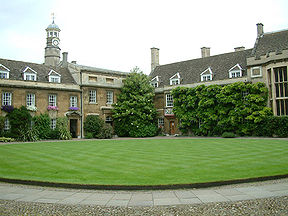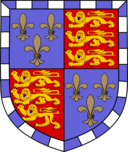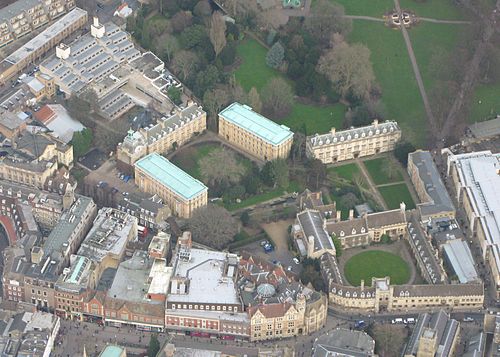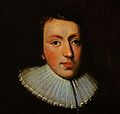- Christ's College, Cambridge
-
Colleges of the University of Cambridge
Christ's College

Founders William Byngham (1437);
Lady Margaret Beaufort (1505)Named after Jesus Christ Established 1437,
Refounded 1505Previously named God's House (1437-1505) Admittance Men and women Master Frank Kelly Undergraduates 395[1] Graduates 95[1] Sister colleges Wadham College, Oxford
Branford College, Yale
Adams House, Harvard
Pforzheimer House, HarvardLocation St Andrew's Street (map) 
Souvent me Souvient
(Old French, "I often remember")College website JCR website Boat Club website Christ's College is a constituent college of the University of Cambridge.
With a reputation for high academic standards, Christ's College averaged top place in the Tompkins Table from 1980-2000 [2]. In 2011, Christ's was placed sixth.
Contents
College history
The college grew from God's House founded in 1437 on land now occupied by King's College Chapel. It received its first royal licence in 1446. It moved to its present site in 1448 when it received its second royal licence. It was renamed Christ's College and received its present charter in 1505 when it was endowed and expanded by Lady Margaret Beaufort, mother of King Henry VII.
Buildings
The original 15th/16th century college buildings now form part of First Court, including the chapel, Master's Lodge and Great Gate tower. The gate itself is disproportionate: the bottom has been cut off to accommodate a rise in street level, which can also be seen in the steps leading down to the foot of L staircase in the gate tower. The college hall, originally built at the very start of the 16th century was restored in 1875-1879 by George Gilbert Scott, the younger. The lawn of First Court is famously round, and an impressive wisteria sprawls up the front of the master's lodge.
Second Court is fully built up on only three sides, one of which is formed by the 1640s Fellows' Building. The fourth side backs onto the Master's garden.
The Stevenson Building in Third Court was designed by J. J. Stevenson, in the 1880s and was extended in 1905 as part of the College's Quadcentenary. In 1947 Professor Richardson designed the second building, the neo-Georgian Chancellor's Building (W staircase), completed in 1950. Third Court's Memorial Building (Y staircase), a twin of the Chancellor's building was completed in 1953 for £80,000.[3] Third Court is also noted for its display of irises in May and June, a gift to the college in 1946.[4]
The controversial tiered concrete New Court (often dubbed "the Typewriter") was designed in the Modernist style by Sir Denys Lasdun in 1966-70, and was described as "superb" in Lasdun's obituary in the Guardian.[5] Design critic Hugh Pearman comments "Lasdun had big trouble relating to the street at the overhanging rear".[6] It appears very distinctively in aerial photographs, forming part of the northern boundary of the college.
An assortment of neighbouring buildings have been absorbed into the college, of which the most notable is The Todd Building, previously Cambridge's County Hall.
Through an arch in the Fellows' Building is the Fellows' Garden. It includes two mulberry trees, of which the older was planted in 1608, the same year as Milton's birth. Both trees have toppled sideways, the younger tree in the Great Storm of 1987, and are now earthed up round the trunks, but continue to fruit every year.[7]

Great Gate 
First Court 
Chapel 
Master's Lodge 
Hall 
Library 
Second Court 
Fellows' Building 
Third Court 
Stevenson Building 
Todd Building 
Four Staircase 
New Court (Lasdun Building) 
Fellows' Garden College societies
The Junior Combination Room, Christ's College Students' Union, is involved in every aspect of student life. Representative of the student body, it organises social and welfare events, and negotiates on the students' behalf on important issues. The Middle Combination Room (MCR) represents the graduate students of Christ's College.
The Marguerites Club is one of the oldest surviving College societies, reformed in 1899 by Gilbert Jessop the then captain of CUCC. It is believed to have originally formed some ten years earlier, but was soon disbanded. Originally the society was confined to captains and secretaries or those with colours in three sports. The name originated from the club's original blazer, which was navy blue in colour with the Foundress's 'rebus' or badge, signifying her name, embroidered on the pocket. Described in the 1908 issue of the college magazine: "The Marguerites have been the premier club of the College in the past, and claim to represent something more than mere athletic distinction".
The oldest College sports society still active is the Christ's College Rugby Football Club (CCRFC). It was founded in 1875 by Alfred Cort Haddon [8], considered the father of modern anthropology. He would later go on to become a Fellow of College and the CCRFC's first Honorary President, and his portrait is now found in Christ's College's Formal Hall. In the 1960 Varsity Match, eight of the starting team were students at Christ's and all points were scored by Christ's players[9]. The CCRFC is nicknamed "The Brown Rings" due to the brown and white hoops featured on the match kit.
The college football team, CCAFC, prides itself on being the most successful Cambridge football side, having won the inter-collegiate Cuppers competition more times than any other.
Also of note is the rowing club, Christ's College Boat Club; the college drama society, CADS; Christ's College Medical Society; Christ's Films, who use the theatre to screen films weekly; the Music Society(founded 1710) and the Chapel Choir: Christ's College Chapel Choir.
The College hosts a biennial May Ball with the most recent, L'Esprit Nouveau, occurring on 15 June 2010 with a 1920s Parisian theme.
Graduate Society
Christ's College Graduate Society comprises a community of approximately 130 graduate students from every part of the world and with diverse academic interests. All members of the Graduate Society also belong to the Christ's College Student Union (CCSU) and share their canteen-style Upper Hall. In addition, the college provides graduates with generous travel bursaries for academic and vacation travel and their own computing facilities. Most graduates are accommodated for three years, either in college or in nearby flats and shared houses.
The Graduate Society is one of the few in Cambridge to run its own bar, specializing in Belgian beers and malt whiskies. There are regular graduate Formal Halls and other events, including wine and cheese tastings, a brewery trip, punting, and outings to Oxford, Ely and Norwich. A Garden Party is held every June in the Fellows' Garden.
Biological Sciences
Christ's College is especially strong in Biological Sciences and has produced alumni that have gone on to become heads of various landmark research institutions. These have included: Hugh Pelham, Director of the MRC Laboratory of Molecular Biology [10]; Daniel St. Johnston, Chairman of the Gurdon Institute [11]; Jim Smith, Director of the MRC National Institute for Medical Research [12]; Richard Treisman, Director of CRUK London Research Institute [13] and Peter Lachmann, Founding President of The Academy of Medical Sciences [14].
Proctors of God's House
- 1439-1451 William Byngham
- 1451-1458 John Hurt
- 1458-1464 William Fallan
- 1464-1477 William Basset
- 1477-1490 Ralph Barton
- 1490-1505 John Sickling
Masters of Christ's
See also: Category: Fellows of Christ's College, Cambridge and Category: Honorary Fellows of Christ's College, Cambridge.
- 1505–1507 John Sickling
- 1507–1510 Richard Wyot
- 1510–1517 Thomas Thompson
- 1517–1530 John Watson
- 1530–1548 Henry Lockwood
- 1548–1553 Richard Wilkes
- 1553–1556 Cuthbert Scot
- 1556–1559 William Taylor
- 1559–1582 Edward Hawford
- 1582–1609 Edmund Barwell
- 1609–1622 Valentine Carey
- 1622–1646 Thomas Bainbridge
- 1646–1654 Samuel Bolton
- 1654–1688 Ralph Cudworth
- 1688–1722 John Covel
- 1723–1745 William Towers
- 1745–1754 George Henry Rooke
- 1754–1780 Hugh Thomas
- 1780–1808 John Barker
- 1808–1814 Thomas Browne
- 1814–1830 John Kaye
- 1830–1848 John Graham
- 1849–1849 Joseph Shaw
- 1849–1881 James Cartmell
- 1881–1887 Charles Anthony Swainson
- 1887–1910 John Peile
- 1910–1927 Sir Arthur Shipley
- 1927–1936 Norman McLean
- 1936–1939 Charles Galton Darwin
- 1939–1950 Charles Raven
- 1950–1963 Brian Downs
- 1963–1978 Alexander R. Todd, Baron Todd
- 1978–1982 Sir John Plumb
- 1982–1995 Sir Hans Kornberg
- 1995–2002 Alan Munro
- 2002–2006 Malcolm Bowie
- 2006– Frank Kelly
See Christ's College by John Peile (1900)
Famous alumni
See also: Category:Alumni of Christ's College, Cambridge
Name Birth Death Career HRH Prince Ra'ad bin Zeid Al-Hussein 1936 Iraqi Prince HRH Prince Zeid Ra'ad Zeid Al-Hussein 1964 Iraqi Prince William Ames 1576 1633 Reformed Theologian Richard Bancroft 1544 1610 Archbishop of Canterbury, Organiser of James I Bible Jagdish Chandra Bose 1858 1937 Bengali physicist Sir Anthony Caro 1924 Sculptor Sacha Baron Cohen 1971 Comedian John Cook 1918 1984 Prolific Anglo-American composer and organist Frederick Cornwallis 1713 1783 Archbishop of Canterbury John Cornwell 1940 author, journalist John James Cowperthwaite 1916 2006 Credited with policies allowing Hong Kong's economic boom in the 1960s Charles Darwin 1809 1882 British naturalist Patrick Arthur Devlin, Baron Devlin 1905 1992 Jurist, Lord of Appeal in Ordinary Colin Dexter 1930 Novelist Sir Martin Evans 1941 Biochemist, Nobel laureate in medicine Noel Gay 1898 1954 Composer Edmund Grindal 1519 1583 Archbishop of Canterbury John Healey 1960 British politician Matthew Hutton 1693 1758 Archbishop of Canterbury Derry Irvine, Baron Irvine of Lairg 1940 Lord Chancellor David Konstant 1930 Bishop of Leeds Sir John Kotelawala 1897 1980 Prime Minister of Ceylon (Sri Lanka) Tony Lewis 1938 England and Glamorgan cricket captain Richard Luce 1936 Lord Chamberlain Michael Lynch 1965 Founder of Autonomy Systems Allama Mashriqi 1883 1963 Founder of the Khaksar Tehreek David Mellor 1949 British politician Miles Millar c 1967 Hollywood screenwriter and producer John Milton 1608 1674 English poet Louis Mountbatten, 1st Earl Mountbatten of Burma 1900 1979 British Admiral of the Fleet and statesman John Oliver 1977 British Political Comedian Andy Parsons 1967 English comedian and writer William Paley 1743 1805 English theologian and philosopher William Perkins 1558 1602 Leading Puritan Theologian of the Elizabethan Era Sir John Plumb 1911 2001 British historian Thomas Plume 1630 1704 English clergyman, founder of the University's Plumian Chair of Astronomy and Experimental Philosophy Roy Porter 1946 2002 British historian Beilby Porteus 1731 1809 Bishop of Chester and Bishop of London, leading reformer and abolitionist Peter Rawlinson, Baron Rawlinson of Ewell 1919 2006 Attorney General for England and Wales Forrest Reid 1875 1948 Cambridge apostle, novelist, literary critic Thomas Robinson, 2nd Baron Grantham 1738 1786 British Foreign Secretary Nicholas Saunderson 1682 1739 British mathematician David Say 1939 2006 British bishop Simon Schama 1945 British historian, author, and television presenter Jan Smuts 1870 1950 Prime Minister of South Africa, Field Marshal, and Commonwealth statesman C. P. Snow, Baron Snow 1905 1980 British novelist and philosopher Nicholas Tarling 1931 Historian Jeffrey Tate 1943 Conductor Henry Teonge 1620 1690 Naval chaplain and diarist Andrew Turnbull, Baron Turnbull 1945 Cabinet Secretary and Head of the Civil Service Kieran West 1977 Olympic gold medalist rower Richard Whiteley 1943 2005 British television presenter Rowan Williams 1950 British theologian, Anglican Archbishop of Canterbury Christopher Zeeman 1925 British mathematician Szeming Sze 1908 1998 Chinese Diplomat, WHO co-founder References
- ^ a b "Undergraduate Admissions: Christ's College". University of Cambridge website. http://www.cam.ac.uk/admissions/undergraduate/colleges/christs/. Retrieved 2009-08-02.
- ^ Christ's top of 20-year table of Cambridge colleges
- ^ Christ's College Magazine, Michaelmas 1953
- ^ Christ's College Magazine no. 228, p 53, 2003
- ^ Architects pay tribute to Denys Lasdun
- ^ The Legacy of Lasdun
- ^ Christ's College Magazine no. 228, p 56, 2003
- ^ Official Christ's College Website; Distinguished Alumni
- ^ Rugby Varsity Match 1960: First Half Highlights.
- ^ Contacts of the LMB
- ^ St. Johnston Group Homepage
- ^ Director's Welcome - NIMR
- ^ Director's Foreword of LRI
- ^ Professor Sir Peter Lachmann at the Academy of Medical Sciences
External links
- Official Christ's College website
- Christ's JCR website
- Christ's MCR website
- Christ's biennial May Ball
- Exhibition celebrating 400 years since the birth of John Milton
- Cambridge 2000 — Christ's College photographs
Coordinates: 52°12′19″N 0°07′20″E / 52.205398°N 0.122223°E
University of Cambridge 
Chancellor: The Lord Sainsbury of Turville (list) · Vice-Chancellor: Sir Leszek Borysiewicz (list)
Colleges: Christ’s • Churchill • Clare • Clare Hall • Corpus Christi • Darwin • Downing • Emmanuel • Fitzwilliam • Girton • Gonville and Caius • Homerton • Hughes Hall • Jesus • King’s • Lucy Cavendish • Magdalene • Murray Edwards (New Hall) • Newnham • Pembroke • Peterhouse • Queens’ • Robinson • St Catharine’s • St Edmund’s • St John’s • Selwyn • Sidney Sussex • Trinity • Trinity Hall • Wolfson
Categories: University • Chancellors • Vice-Chancellors • Colleges • Heads of Colleges • Departments • Academics • Alumni • Awards and Prizes
Websites: University • Students’ Union • Graduate Union
 Categories:
Categories:- Colleges of the University of Cambridge
- Educational institutions established in the 1500s
- Gardens in Cambridgeshire
- 1505 establishments in England
- Denys Lasdun buildings
- Christ's College, Cambridge
- Grade I listed buildings in Cambridgeshire
- Grade I listed educational buildings
Wikimedia Foundation. 2010.

















